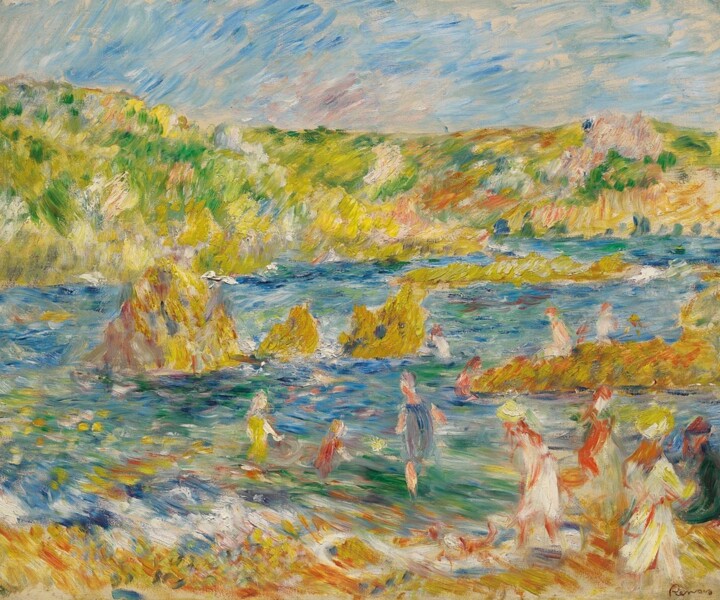 Rocks of Guernsey with Figures (Beach at Guernsey), 1883, Pierre-Auguste Renoir
Rocks of Guernsey with Figures (Beach at Guernsey), 1883, Pierre-Auguste Renoir
The arts may not be as well known on the British island of Guernsey as its reputation as a tax haven for the very rich. But a traveling show that will open there this summer will show a different side of the island: how it inspired the French Impressionist painter Pierre-Auguste Renoir. Renoir in Guernsey, 1883 will focus on the 15 landscapes the artist painted there during a five-week trip in 1883. The organizers, led by the charity Art for Guernsey, have secured 12 of these works for the Guernsey leg of the show, including loans from the National Gallery in London and the Cincinnati Art Museum, as well as from private collections, with help from Christie's. Rochers de Guernesey avec personnages (plage à Guernesey) (1883) was bought by a group of local buyers, including Art for Guernsey founder David Ummels, at Christie's London for £443,250 (including fees) in 2020.
Before going to the Candie Museum on the island from September 30 to December 15, the exhibition will be shown at the Musée des impressionnismes in Giverny, France, from July 14 to September 10. The Musée des impressionnismes's fame and ties to the Musée d'Orsay also helped to get the loans. Cyrille Sciama, who runs the Giverny museum and has been a friend of Art For Guernsey for a long time, put together the show. As part of the charity's Renoir Walk program, he went to the island in 2019 to record talks about how the artist felt about its scenery. As part of an effort to get people to follow in the artist's ways, the landscape of Guernsey was framed to look like Renoir's paintings and Sciama gave talks to go with them.
Sciama says that Renoir's stay in Guernsey was crucial to his artistic growth at a time when he was bored and not making any progress. "There are more than just 15 works about Guernsey in the show. His time on the island made him feel free, which made his style more interesting." Marine Guernesey (1883) is a picture that will not be at the Guernsey part of the show. In February, a Parisian administrative court told the Musée d'Orsay to give the painting back to the family of the important French dealer Ambroise Vollard. During the Second World War, the picture was stolen and then sold to the Nazis. The picture was never meant to be part of the Guernsey leg, but it will be at the Giverny leg. "A little over two years ago, the curator told us that the painting couldn't leave France because a court decision was coming up," Ummels says. The Candie show will be part of a bigger celebration of Renoir's trip, which happened 140 years ago. It will have events and shows at the Priaulx Library, the Renoir Walk, and the Art for Guernsey gallery, which just opened in the Old Quarter of the island. The new gallery will show works by artists like Banksy, Thomas Gainsborough, Francisco de Goya, Andy Warhol, and Renoir that are owned by local people.
 View of Guernsey, 1883, Pierre-Auguste Renoir
View of Guernsey, 1883, Pierre-Auguste Renoir
Art for Guernsey also has a residency program where artists can live and work on projects that are then shown in Guernsey. Ummels says that the island's special location between the UK and France gives it a chance to build relationships with both countries. Sciama agrees with this idea. The exchange between the two places is based on how important "tourism, culture, and children" are and how art helps all three. Sciama says that a ceremony with the mayors of both cities is planned for the summer to make the relationship between them official. Giverny is already a center for art. It is home to the Impressionism museum and the Fondation Claude Monet, as well as the artist's home, which gave him ideas for many of his works. But for Guernsey, Ummels sees a chance for a rebranding in the exhibition and its wider context. "Guernsey was a place where British and French artists went in the 1800s to get ideas." Since then, he says, the island has made money from granite, fruit, tourists, and, most famously, avoiding taxes. "I really believe in the island and the people who live here," Ummels says. "I think art has a role to play in bringing people together and giving us a chance to show the UK, France, and other countries who we are again."


 Selena Mattei
Selena Mattei